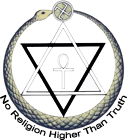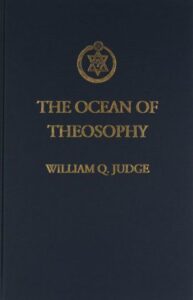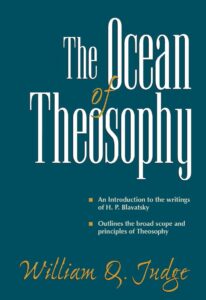Studies In The Ocean of Theosophy Part XXIII
Theosophy Magazine
Vol. 22, No. 11 Septermber 1934
pages 512 - 515
Part XXIII
THE after-death states of consciousness known as Kama Loka and Devachan may be regarded as first the vices and the virtues entered in the life-ledger, taking form before the mind of the man retreating from earthly existence. While experiencing these states, respectively, he functions in those phases of purely astral matter corresponding to them. The plane of astral substance, being that in which passion and desire inhere, forms the matrix of the fourth human sheath — the Balance Principle, from which the ways go up or down.
If, during life here, the personal tendencies are governed and the powers of the being are directed into constructive channels, there can be little to detain the departing Soul in Kama Loka, the field provided by Nature for the solitary blossoming of all selfish desires still unconquered. But whatever evil lies hidden in the heart springs spontaneously into expression, for the ruling force of this first state after death is “desire devoid of and divorced from intelligence.” Herein lies a lesson in self-scrutiny and self-honesty; since no poison bloom can unfold there, the bud of which was not already set, here. In fact, earth-life is the active Kama-Loka; and the state after death only its passive aspect. The latter being entirely subjective and without choice, obviously its cause lies in the kamic choices made during the physical lifetime.
Earth being the place where choice may be exercised is, of course, as amenable to the production of Devachan as to Kama Loka, according to how the principle of desire is employed. But its highest use lies in subjecting it to the dictates of the higher nature. Thus surmounting illusions, both demoniacal and divine, the free Soul could pass through the states after death, consciously, on the passage to his own place. As Humanity now tends, personal desire will remain its motive power “until at a far distant time in the course of evolution the races of men shall have developed the fifth and sixth principles, thus throwing kama into its own sphere and freeing earth-life from its influence.”
The sojourn in Kama Loka is an isolated one. The tangled wilderness where the man struggles is all his own; but, lacking contrasts, comparison is impossible and, hence, the suffering undergone is without realization, like the horrors endured in a nightmare. Therefore, the state is not strictly punitive, but purificatory, permitting all evils, even to their seed-thoughts, to expand to fullest potency, decline, and wither away, leaving the mind cleansed of its dross for awhile.
Although the vitality of these kamic unfoldments is eventually exhausted, every growth in it leaves its seeds for future harvests, here. Earth is the true place of retribution; because it is only by means of the pairs of opposites that things may be seen for what they are. Punishment without comprehension of its reason, or chance to make amends for errors, would be rank injustice; and Life’s inherent object is not to avenge, but to teach.
All seeds awaiting the incoming Ego at the threshold of incarnation are portions of the skandhas, “the aggregates that make up the man.” The physical body includes one set, the astral man another, the kama principle another, and so on; but in kama are the really active and important skandhas, “which control rebirths and lead to all the varieties of life and circumstance upon each rebirth. They are being made from day to day under the law that every thought combines instantly with one of the elemental forces of nature, becoming to that extent an entity which will endure in accordance with the strength of the thought as it leaves the brain, and all of these are inseparably connected with the being who evolved them.” Inasmuch as Man is continually thinking, there “is no way of escaping; all we can do is to have thoughts of good quality, for the highest of the Masters themselves are not exempt from this law, but they ‘people their current in space’ with entities powerful for good alone.”
As treated in this chapter, the subject of skandhas illustrates the co-existence and co-eternality of Spirit and Matter, showing, as it does, the necessity for a substance aspect for each degree of consciousness. No thought or feeling but requires an appropriate vehicle. Otherwise, there could be no expression. These material bases are composed of the elementals, innumerable and of almost infinite divisions and each class having its own work to do. “As fire burns and as water runs down and not up under their general law, so the elementals act under law, but being higher in the scale than gross fire or water their action seems guided by mind.” In endless gradation, these elementals provide instrumentation for every possible thought. They “are, in a sense, the nerves of nature,” carrying the impulses of desire either to further or obstruct Evolution.
Consideration of these facts also make it clearer how Man clothes himself in veil within veil of fabric, self-woven; and how the garment used after demise — the same in which nightmare is experienced during life — is woven with the being’s own threads of kamic thought.
When the process of dying severs the astral body from the rest, Kama at once coalesces with it, forming the Kama Rupa, or astral “shell.” In this form, the entire “mass of desire and thought exists very definitely until the conclusion of its disintegration, and then the remainder consists of the essence of these skandhas, connected, of course, with the being that evolved and had them” and no more to be done away with “than we can blot out the universe,” but remaining “until the being comes out of devachan,” when “at once by the law of attraction they are drawn to the being, who from them as germ or basis builds up a new set of skandhas for the new life.”
The perpetuation of Kama Loka in vicious cycles, from birth to birth, is comparable to a growth of noxious weeds; but the simile used by Mr. Judge is more fitting as regards the period between death and rebirth. He calls it the slag-pit “of the great furnace of life, where nature provides for the sloughing off of elements which have no place in devachan.” Just as the red-hot slag dumped in the pit is waste separated from the pure metal; so Kama Loka is the repository for all taints acquired in the lifetime. But at length casting off his burdens of sin, the spiritual Wayfarer sinks deeper into his own nature. Leaving personal desires behind, he rests, for a while, in the bliss of personal realization of the noblest of his human dreams and aspirations during the life just closed. And, as the glowing, molten slag gradually cools and hardens to gray and barren inertia; so, when the Ego has fled, the flaming passions die down, then fade away, leaving but cold, bleak dregs of selfishness — unless rekindled by mediumistic practices.
Purported communications with the departed, far from being such, are largely the work of elementals, some of which “have a special relation to mental operations and to the action of the astral organs, whether these be joined to a body or not.” Using the medium as a channel and “aided by the nervous fluid of the medium and others near,” these elemental forces can galvanize the shell, or astral corpse, into an artificial life. Connected in this way, “old impressions on the astral body give up their images to the mind of the medium, the old passions are set on fire. Various messages and reports are then obtained from it, but not one of them is original, not one is from the spirit,” but all are from the living when “not the mere picking out from the astral light of the images of what has been in the past.”
Were alleged communications with the dead merely cheats and time wasters, the case would not be so tragic; but what “can and do influence the sensitive and the medium from out of this sphere are the shells,” or the “brutal earthly portion discarded in the flight to devachan.” Soulless and conscienceless, their apparent consciousness is but the echo of the “recent association with the human Ego.” Because every atom has memory, and astral substance absorbs all impressions, the astral sheath “contains and carries the record of all that ever passed before the person when living”; and this can be reflected from the shell “when conditions permit.”
The dabbler in necromancy attunes his own kamic nature to baleful influences indeed. It is a motley crowd that he invites: shadowy ghosts of the long deceased, disintegrating corpses of the recently departed, and living astral forms of suicides, victims of accident or murder, and “those poor wretches who die at the hand of the law” — all being containers of whatever of drunkenness, gluttony, malice, and lust may have been left by their users. But, worst of all, the dreadful “coherent entities, human souls bereft of the spiritual tie,” doomed to conscious annihilation, yet dwelling long in the astral sphere, of which they have “a complete mastery.” “They are known as black magicians. Having centered the consciousness in the principle of kama, preserved intellect, divorced themselves from spirit, they are the only damned beings we know.” They love to preside at seances, “assuming high names and taking direction” and “are liable to invade the sphere of any medium no matter how good. The door once open, it is open to all.” He who would raise the lower portion of manas up to godlike excellence need beware of psychism, lest these dark tempters lure him also to permit manas to be “torn away from its lord.”
Even without mediumship, dangers enough threaten, due to the influences emanating from the “astral region penetrating and surrounding the earth.” Our planet rolls in its path through space enshrouded by this zone of dark shadows and lurid lights, representing the dregs of mistaken and of vicious action. Until true and high aims are entertained, Mankind must endure the constricting coils of Kama Loka, subject to its pictures of crime and its whisperings, that incite the worst in human nature.
Theosophy’s teaching concerning passion and desire is in conflict with modern ideas and shows the crying need of truer education and better understanding of Man, his powers and constitution. For the great truths of Life, Death, and Nature remain unchanged, however much ignored. Denial does not set the law aside nor save from the results of unwise living and present subjection to the Kamic Principle, which can and should be made a valuable tool and means of evolution.
Back to The Ocean of Theosophy



